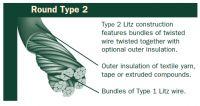CataM
Advanced Member level 4
- Joined
- Dec 23, 2015
- Messages
- 1,275
- Helped
- 314
- Reputation
- 628
- Reaction score
- 312
- Trophy points
- 83
- Location
- Madrid, Spain
- Activity points
- 8,409
Hello everyone,
I have Litz wire of 750 strands with 0,2 mm diameter of each wire. Diameter of the total wire (all strands together) counting insulation in is: 7,5 mm (measured). Without insulation (calculated, not measured) it is ~√750 *0,2 = 5,47 mm => it will be a bit more like 27,7x i.e. 27,7*0,2 = 5,54 mm (without insulation).
My litz wire is like in the below picture.

I would appreciate your advice on how to make the terminal connector of the Litz wire. It will be connected to a PCB having a high power circuit (class D power inverter on the full bridge configuration).
I have found some terminals in the following link, but I do no know if those are good for a final PCB connection ? http://www.cardas.com/parts.php
Please recommend me whatever kind of terminal from whatever part of the world (ebay,amazon etc..). It would definitely help me a lot because I have no idea !
Thank you in advance !
I have Litz wire of 750 strands with 0,2 mm diameter of each wire. Diameter of the total wire (all strands together) counting insulation in is: 7,5 mm (measured). Without insulation (calculated, not measured) it is ~√750 *0,2 = 5,47 mm => it will be a bit more like 27,7x i.e. 27,7*0,2 = 5,54 mm (without insulation).
My litz wire is like in the below picture.

I would appreciate your advice on how to make the terminal connector of the Litz wire. It will be connected to a PCB having a high power circuit (class D power inverter on the full bridge configuration).
I have found some terminals in the following link, but I do no know if those are good for a final PCB connection ? http://www.cardas.com/parts.php
Please recommend me whatever kind of terminal from whatever part of the world (ebay,amazon etc..). It would definitely help me a lot because I have no idea !
Thank you in advance !